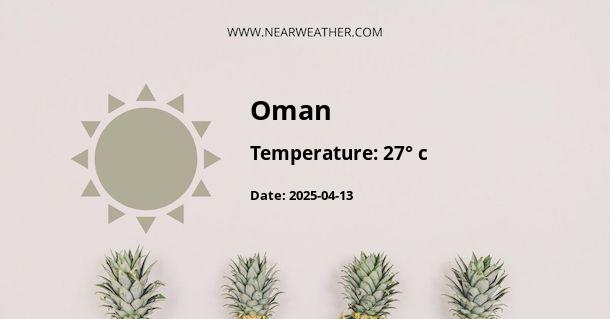Climate and Weather in the Sultanate of Oman
The Sultanate of Oman is located in the southeastern part of the Arabian Peninsula, bordering the Arabian Sea and the Gulf of Oman. It has a diverse climate and a range of weather conditions throughout the year. The country is known for its hot and dry summers, mild winters, and occasional rainfall.
Summer (June to September)
The summer season in Oman is characterized by extremely high temperatures and low humidity. The coastal areas experience temperatures ranging from 35°C (95°F) to 45°C (113°F), while the interior regions can reach even higher temperatures, sometimes exceeding 50°C (122°F). The southern parts of Oman, such as Salalah, benefit from the Khareef season during the summer months, which brings cooler temperatures and monsoon-like rainfall.
The high temperatures during summer make it challenging for outdoor activities, and it is recommended to stay hydrated and avoid prolonged exposure to the sun. The coastal areas also experience high levels of humidity, which can make the heat feel even more intense.
Autumn (October to November)
Autumn in Oman brings a relief from the scorching heat of summer. The temperatures start to decrease gradually, and the weather becomes more pleasant, especially in the coastal areas. Average temperatures range from 25°C (77°F) to 35°C (95°F) during this season.
Autumn is a great time to explore Oman's natural beauty, such as its stunning beaches and wadis (dry riverbeds). It is also a popular time for outdoor activities like hiking and camping.
Winter (December to February)
Winter in Oman is mild and comfortable, with temperatures ranging from 15°C (59°F) to 25°C (77°F) in most parts of the country. The coastal areas experience slightly higher temperatures, while the mountainous regions can be cooler, especially at night.
During winter, Oman experiences occasional rainfall, which helps to cool down the temperatures and create a pleasant atmosphere. The mountains of Oman, like Jebel Akhdar and Jebel Shams, often receive more rainfall and can even experience snowfall, offering a unique experience for visitors.
Spring (March to May)
Spring in Oman is characterized by increasing temperatures as summer approaches. Average temperatures range from 20°C (68°F) to 35°C (95°F). The weather is generally dry and sunny, with occasional dust storms, especially in the desert areas.
Spring is a popular time for outdoor activities in Oman, such as exploring the deserts, visiting the ancient forts and ruins, and enjoying water sports along the coastline.
Climatic Regions of Oman
Oman can be divided into four main climatic regions:
- Coastal Areas: The coastal regions of Oman experience high levels of humidity and mild temperatures throughout the year. The coastal strip along the Arabian Sea is influenced by the monsoon winds, which bring moisture and occasional rainfall during the summer months.
- Interior Regions: The interior regions of Oman, including the capital city Muscat, have hot and dry summers, with temperatures often exceeding 40°C (104°F). Winters are mild and comfortable, with cooler temperatures at night.
- Desert Areas: The desert areas in Oman, such as the Wahiba Sands and the Empty Quarter, have extreme temperatures, with scorching hot summers and cold winters. Daytime temperatures in summer can reach well above 50°C (122°F), while winter nights can be chilly.
- Mountainous Regions: The mountainous regions of Oman, including Jebel Akhdar and Jebel Shams, have cooler temperatures compared to the rest of the country. These areas receive more rainfall, especially during winter, and can even experience snowfall.
Annual Rainfall
Oman generally has a very low annual rainfall, with most of the country receiving less than 100mm (4 inches) of rainfall per year. The southern region of Salalah, however, receives a significant amount of rainfall during the Khareef season, with an average of 300mm (12 inches) per year.
The low rainfall and arid conditions make water conservation and management crucial in Oman. The country has invested in desalination plants and other water management techniques to meet the water needs of its population.
Conclusion
The Sultanate of Oman has a diverse climate, ranging from hot and dry summers to mild winters with occasional rainfall. It is important to consider the weather conditions when planning a visit to Oman, especially during the summer months when temperatures can be extremely high. Spring and autumn offer more pleasant temperatures, while winter provides a mild climate with occasional rainfall. Whether you are interested in exploring the coastal areas, desert landscapes, or mountainous regions, Oman offers a variety of climates and weather conditions to suit different preferences.
A - Oman's Latitude is 21.000000 & Longitude is 57.000000.
A - Weather in Oman is 27° today.
A - Climate Conditions in Oman shows clear sky today.
A - Humidity in Oman is 62% today.
A - Wind speed in Oman is 26.21 km/h, flowing at 184° wind direction. today.
